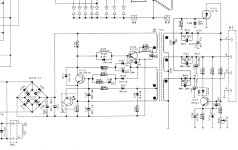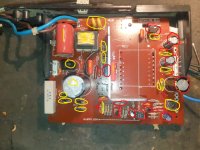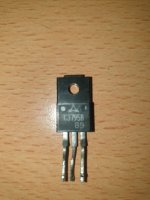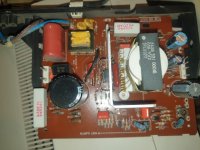Hi at all, another question for my pieces in collection... I have buyed an old 1084 Monitor (without S on model number) in not working condition. It's arrived 3 days ago and i have opened it for checking. The monitor board don't have any problem, abount 2 capacitors in lost and i have replaced, the flyback is ok, but it is not a most common HR7406 or 7533 model, this board is a 1081 board with more big flyback fixed with screw on the PCB.
The problem is on a power supply, if i disconnect all cable from it and test it out of the monitor i' don't have the three voltage on output (125v 26v5v and 15,5v), but i have 30v on 125v rail, 6 volt on 26,5 rail and 4 volt on 15,5 rail)
I have replaced all 1n4148 diodes and all electrolityc capacitors, and checked all resistors and other orange not polarizec caps, all are fine. Then i have replaced dhe BUT11AF and the TRIAC buth nothing.
I have suspect for the optocoupler CNX62A because the upper mensined voltage slowing going ap to the mensioned value, i have the 178v con the degause output.
Primary circuit is ok, i have 360volt on big caps and same voltage on the BUT11AF, then i have approximately 300 volt on input of Switching transformer.
The fuse not blown, if i reconnect on the monitor i have the same voltage and the power led coing on slowely, not have any reaction from monitor board because the voltage are loss from power supply.
Anyone have an idea, or anyone have spare powersupply to sell? I will try with new opto coupler but if not resolve i need a chance to repair it.
Exist a replacement modenr power suply for this monitor?
Thanks
Emanuel
The problem is on a power supply, if i disconnect all cable from it and test it out of the monitor i' don't have the three voltage on output (125v 26v5v and 15,5v), but i have 30v on 125v rail, 6 volt on 26,5 rail and 4 volt on 15,5 rail)
I have replaced all 1n4148 diodes and all electrolityc capacitors, and checked all resistors and other orange not polarizec caps, all are fine. Then i have replaced dhe BUT11AF and the TRIAC buth nothing.
I have suspect for the optocoupler CNX62A because the upper mensined voltage slowing going ap to the mensioned value, i have the 178v con the degause output.
Primary circuit is ok, i have 360volt on big caps and same voltage on the BUT11AF, then i have approximately 300 volt on input of Switching transformer.
The fuse not blown, if i reconnect on the monitor i have the same voltage and the power led coing on slowely, not have any reaction from monitor board because the voltage are loss from power supply.
Anyone have an idea, or anyone have spare powersupply to sell? I will try with new opto coupler but if not resolve i need a chance to repair it.
Exist a replacement modenr power suply for this monitor?
Thanks
Emanuel




